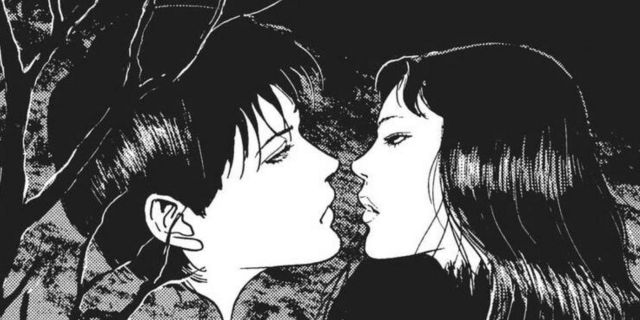The following contains spoilers for Junji Ito Collection: Shiver, “Hanging Blimp,” now available from Viz Media, as well as discussion of suicide and self-harm.
On January 19, 2023, Netflix released Junji Ito Maniac: Japanese Tales of the Macabre, which adapted some of the horror manga artist’s most bizarre and horrific tales into an anime collection. Among the stories included was a tale called “The Hanging Balloons,” a twisted and macabre tale about a young girl trapped inside her home while a ballooned version of her own head taunts her to come outside.
“The Hanging Balloon,” originally published in the collection titled Shiver: Junji Ito Selected Stories, explores themes of life, pressure, toxic fandom, love, death and suicide that often leave readers and viewers scratching their heads. Coupled with some seriously disturbing imagery, it’s easy to get distracted by the horror aspects without considering what, if any, hidden meaning exists in “The Hanging Balloon.”
The Hanging Balloons’ Commentary on Japan’s High Suicide Rates
While both Tomie and Souichii Tsujii are anthology series, “The Hanging Balloons” stands out as the only self-contained story Junji Ito Maniac will be adapting. Why is that? Is there something about the story that really stands out as a classic or is it a story with a hidden meaning? Upon deeper analysis, both may be true, as “The Hanging Balloons” is not only a well-crafted story with well-laid-out panels and outstanding artwork but also offers some very layered commentary on Japan’s high suicide rate.
As a story, “The Hanging Balloons” (adapted by Viz Media as “Hanging Blimp”) centers around the suicide of a teenage Japanese idol named Terumi Fujino and the domino effect this has on teen suicides all across the country. This is not unheard of in Japan; in fact, it’s well documented that celebrity suicides are often followed by spikes in suicides within a 10-day period. In the story itself, Terumi’s death is treated as a national shock and the state of her mental health is sensationalized. Terumi feels pressured to perform and feeling uncertain about her future — a common source of stress among young Japanese people, who are often contracted for short-term jobs.
The Taboo of Mental Health Prevails in The Hanging Balloons

Incidentally, “The Hanging Balloons” spotlights another social issue in Japan: the taboo surrounding the topic of mental health. As a rule-oriented society and culture, Japan values group harmony over individual expression since the survival of the whole country is dependent on this system. As such, differing opinions are discouraged and open conversations about difficult topics like mental health are avoided to prevent the disruption of collective comfort. Without the freedom to openly express what’s on one’s mind, this increases the likelihood of social isolation, which in turn worsens depression symptoms and increases the likelihood of suicide. This topic is metaphorically explored with the characters of Kazuko and Shinya Shiraishi.
Throughout the story, Kazuko is grieving the loss of Terumi, who was also her classmate and best friend. Despite the fact that hundreds of other people are also grieving Terumi’s death, at no point does Kazuko share her feelings with her friends and family, who are also grieving her loss. Instead, Kazuko internalizes her feelings. The same is true of Shiraishi, who was Terumi’s boyfriend in the story (and was even blamed for her suicide by her fans). This led to him being ganged up on by Terumi’s fans and bullied, thus exploring another driving force of suicide, especially in the age of social media: toxic fandom.
The Hanging Balloons Symbolize Suicidal Thoughts

In Shiraishi’s case, Terumi’s fans engaged in abusive behavior toward him, which worsened his depression and suicidal ideation. This is when the “balloons” start to appear in the story, with the “ghostly head of Terumi” being the first to appear. This is followed by the appearance of Shiraishi’s head, which has a noose hanging from his head, symbolizing his thoughts of suicide. When Shiraishi goes to meet with “the ghost” of his deceased girlfriend, his head balloon captures his neck into the noose and hangs him. Shortly after Shiraishi joins Terumi in death, more head balloons start to appear, including Kazuko’s.
One by one, the head balloons start “claiming” the lives of large numbers of people all over Japan, with Kazuko being the last to go. The fact that Kazuko ends up isolating herself inside her house before her balloon “gets” her is consistent with suicide trends as they are observed in Japan. Furthermore, the fact that the people are hanged by balloons that resemble their severed heads is a commentary on how people contemplating suicide don’t usually show that they are suicidal until it is too late.
For more information on the warning signs and prevention of suicide, click here. If you or someone you know is in emotional distress or considering suicide, call the National Suicide Prevention Lifeline at 1-800-273-TALK (8255). If you live outside the U.S., click here for a list of international hotlines.
Junji Ito Maniac: Japanese Tales of the Macabre is available to stream on Netflix.










